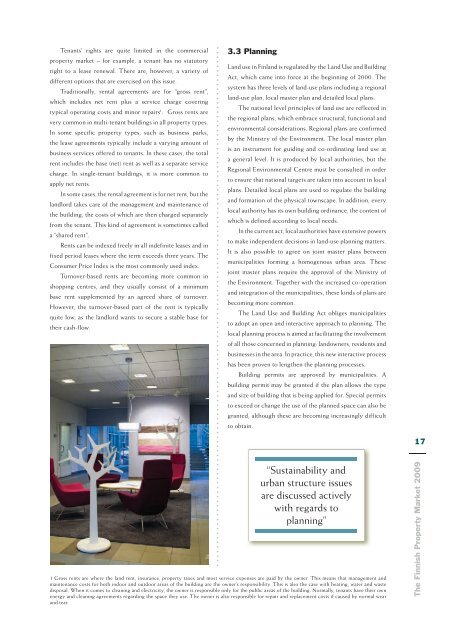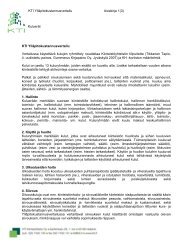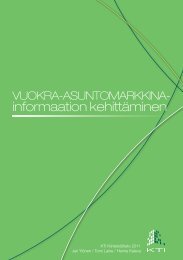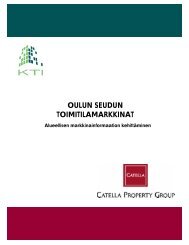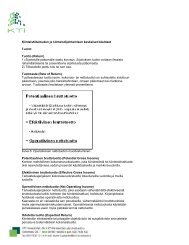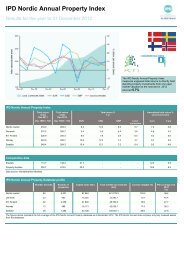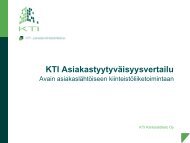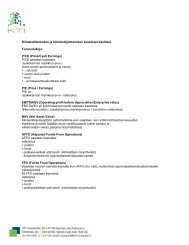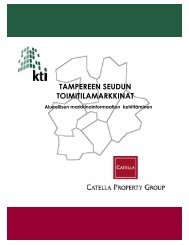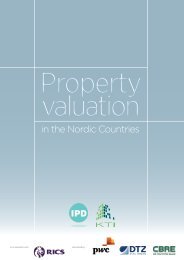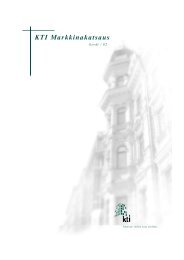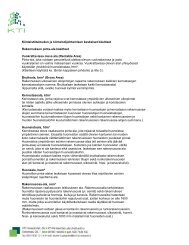The Finnish Property Market 2009 - KTI
The Finnish Property Market 2009 - KTI
The Finnish Property Market 2009 - KTI
You also want an ePaper? Increase the reach of your titles
YUMPU automatically turns print PDFs into web optimized ePapers that Google loves.
Tenants’ rights are quite limited in the commercial<br />
property market – for example, a tenant has no statutory<br />
right to a lease renewal. <strong>The</strong>re are, however, a variety of<br />
different options that are exercised on this issue.<br />
Traditionally, rental agreements are for “gross rent”,<br />
which includes net rent plus a service charge covering<br />
typical operating costs and minor repairs 1 . Gross rents are<br />
very common in multi-tenant buildings in all property types.<br />
In some specific property types, such as business parks,<br />
the lease agreements typically include a varying amount of<br />
business services offered to tenants. In these cases, the total<br />
rent includes the base (net) rent as well as a separate service<br />
charge. In single-tenant buildings, it is more common to<br />
apply net rents.<br />
In some cases, the rental agreement is for net rent, but the<br />
landlord takes care of the management and maintenance of<br />
the building, the costs of which are then charged separately<br />
from the tenant. This kind of agreement is sometimes called<br />
a “shared rent”.<br />
Rents can be indexed freely in all indefinite leases and in<br />
fixed period leases where the term exceeds three years. <strong>The</strong><br />
Consumer Price Index is the most commonly used index.<br />
Turnover-based rents are becoming more common in<br />
shopping centres, and they usually consist of a minimum<br />
base rent supplemented by an agreed share of turnover.<br />
However, the turnover-based part of the rent is typically<br />
quite low, as the landlord wants to secure a stable base for<br />
their cash-flow.<br />
3.3 Planning<br />
Land use in Finland is regulated by the Land Use and Building<br />
Act, which came into force at the beginning of 2000. <strong>The</strong><br />
system has three levels of land-use plans including a regional<br />
land-use plan, local master plan and detailed local plans.<br />
<strong>The</strong> national level principles of land use are reflected in<br />
the regional plans, which embrace structural, functional and<br />
environmental considerations. Regional plans are confirmed<br />
by the Ministry of the Environment. <strong>The</strong> local master plan<br />
is an instrument for guiding and co-ordinating land use at<br />
a general level. It is produced by local authorities, but the<br />
Regional Environmental Centre must be consulted in order<br />
to ensure that national targets are taken into account in local<br />
plans. Detailed local plans are used to regulate the building<br />
and formation of the physical townscape. In addition, every<br />
local authority has its own building ordinance, the content of<br />
which is defined according to local needs.<br />
In the current act, local authorities have extensive powers<br />
to make independent decisions in land-use planning matters.<br />
It is also possible to agree on joint master plans between<br />
municipalities forming a homogenous urban area. <strong>The</strong>se<br />
joint master plans require the approval of the Ministry of<br />
the Environment. Together with the increased co-operation<br />
and integration of the municipalities, these kinds of plans are<br />
becoming more common.<br />
<strong>The</strong> Land Use and Building Act obliges municipalities<br />
to adopt an open and interactive approach to planning. <strong>The</strong><br />
local planning process is aimed at facilitating the involvement<br />
of all those concerned in planning: landowners, residents and<br />
businesses in the area. In practice, this new interactive process<br />
has been proven to lengthen the planning processes.<br />
Building permits are approved by municipalities. A<br />
building permit may be granted if the plan allows the type<br />
and size of building that is being applied for. Special permits<br />
to exceed or change the use of the planned space can also be<br />
granted, although these are becoming increasingly difficult<br />
to obtain.<br />
17<br />
“Sustainability and<br />
urban structure issues<br />
are discussed actively<br />
with regards to<br />
planning”<br />
1 Gross rents are where the land rent, insurance, property taxes and most service expenses are paid by the owner. This means that management and<br />
maintenance costs for both indoor and outdoor areas of the building are the owner’s responsibility. This is also the case with heating, water and waste<br />
disposal. When it comes to cleaning and electricity, the owner is responsible only for the public areas of the building. Normally, tenants have their own<br />
energy and cleaning agreements regarding the space they use. <strong>The</strong> owner is also responsible for repair and replacement costs if caused by normal wear<br />
and tear.<br />
<strong>The</strong> <strong>Finnish</strong> <strong>Property</strong> <strong>Market</strong> <strong>2009</strong>


